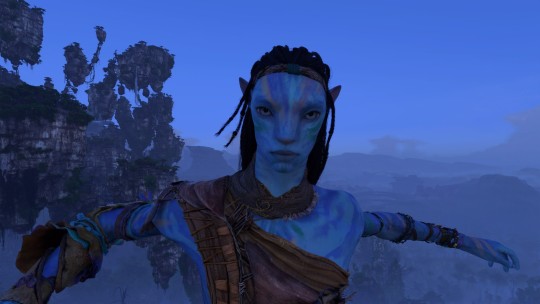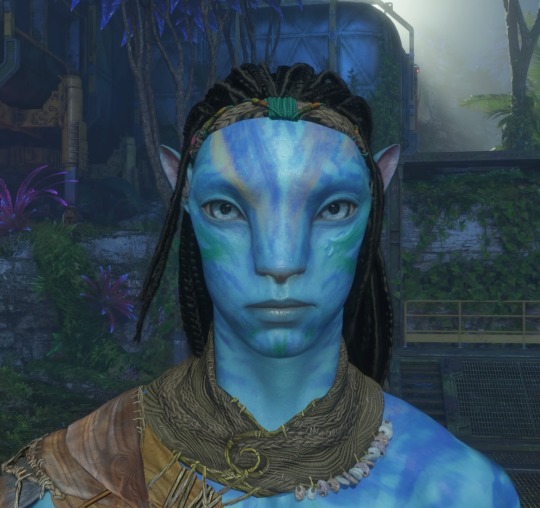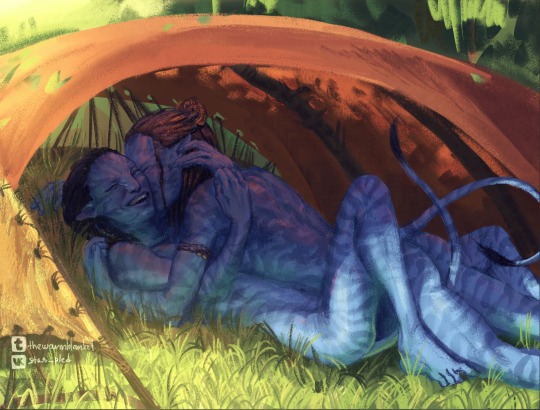#zeswa appreciation
Text
Meet Zuri of the Zeswa!

I- I don't know if text in na'vi is correct grammatically but translation has a slightly different meaning that's intentional
#that one gay na'vi now has a name!#avatar#avatar the way of water#avatar frontiers of pandora#avatar oc#avatar art#zeswa clan#zeswa appreciation#lì'fya lena'vi#na'vi language
1K notes
·
View notes
Text
Can we just have a moment of appreciation for my boy?



I mean, come on. My loves are So'lek, then Eetu, and then Okul and/or some random guy from the Zeswa clan whose name I don't remember...
But I would absolutely marry my boy if I could.
Silo te Zewpä 'Okxsou'itan <3
#avatar frontiers of pandora#solek avatar#avatar#eetu#eetu avatar#avatar frontiers oc#okul#okul avatar
69 notes
·
View notes
Text
Meet The Clans Of Avatar: Frontiers Of Pandora
New Post has been published on https://thedigitalinsider.com/meet-the-clans-of-avatar-frontiers-of-pandora/
Meet The Clans Of Avatar: Frontiers Of Pandora

Avatar: Frontiers of Pandora introduces three brand-new clans to the Avatar universe: the Aranahe, Zeswa, and Kame’tire. Each tribe calls one of the Western Frontier’s three biomes – Kinglor Forest, Upper Plains, and Clouded Forest, respectively – home. Ingratiating yourself with each one by learning their ways is an important step in your journey to reclaim your Na’vi culture, as well as garnering enough support to push back against the exploitative mining of the villainous RDA.
For a heads-up on what to expect as you try to warm up to each clan, here’s a breakdown of the culture and personality.

Aranahe
The first clan you encounter resides in the Kinglor Forest. Like the Omatikaya clan from the first film, the Aranahe live in a Hometree and have a symbiotic relationship with Kinglor, large moth-like creatures. That’s because the clan primarily consists of weavers and artisans, so these Na’vi rely on the Kinglor’s silk to create extravagant and intricate fabrics. The silk’s strong fiber is also applied to weapon crafting, such as making powerful bow strings. In return for these gifts, the Aranahe serve as caretakers for the Kinglor.
Unfortunately, this balance becomes disrupted by the RDA’s presence in the area, and one of your first tasks is restoring this way of life. Rallying the clan to retaliate won’t be easy, though. The Aranahe’s refined tastes mean they have a proud, somewhat superior attitude. When you initially meet them, their leader, Kan’nat, is in a bit of denial about the dire situation and distrusts you and the resistance, burying his head in the sand to the chagrin of his rebellious daughter, Etuwa.
Nonetheless, the Aranahe is a peaceful and orderly tribe that values consensus over individual needs.

Zeswa
This colorful, boisterous, and ferocious warrior clan roam the hilly grasslands of the Upper Plains. Their eagerness for battle means that, unlike the Aranahe, they seek out the player’s help in fighting RDA. You can easily spot their settlements thanks to their large, colorful kites that soar overhead thanks to the Upper Plains’ perpetually windy environment.
The Zeswa are nomadic due to the fact that they travel alongside large, docile creatures called zakru. These peaceful, elephant-like animals produce milk that forms the basis of the Zeswa’s diet. Zakru rarely move and survive by burying their trunks underground to feed on bacteria in the earth. The Zeswa’s tents are pitched on and around their stationary bodies to shield them from the Upper Plains’ powerful winds. When the zakru finally move on, which developer Massive describes as a once-in-a-generation occurrence, the clan moves with them.
According to narrative designer Chella Ramanan, Massive looked at Kenya’s Maasai tribe as a primary influence for the Zeswa. This is reflected in the Zeswa’s hues of red and yellow for their fabrics and their beautiful braided hairstyles that sometimes resemble horns. These Na’vi love to have fun as much as they love to fight. According to Ramanan, they’ll even welcome you with a party once you prove yourself to them as a capable warrior.

Kame’tire
Search well enough and you’ll find this secretive tribe hidden within the foggy depths of the Clouded Forest. Reclusive, introverted, and as mysterious as their home, the Kame’tire are expert apothecaries and herbalists. Their intimate knowledge and appreciation for plant life is also reflected in their organic clothing. That includes imposing armor made through wood shaping, the art of softening and sculpting wood into different shapes.
Befitting the nature of the clan, Massive was the most cagey about sharing specifics for the Kame’tire. We do know that no one has seen the clan for some time, as they’ve chosen to live in self-seclusion. Personality-wise, Ramanan describes the Kame’tire as “moody,” “suspicious,” and “a bit brutish” compared to the other two clans, and they are not eager warriors. They would rather conceal the things they value than physically defend them. Most of all, the Kame’tire are renowned caretakers and, despite their wariness of outsiders, would make valuable allies.
Avatar: Frontiers of Pandora launches on December 7 for PlayStation 5, Xbox Series X/S, and PC. Be sure to subscribe to the magazine to read the digital edition now, and visit our cover story hub by clicking the banner below to find more exclusive features and videos this month.
#Animals#armor#Art#avatar#Bacteria#clothing#december#Developer#diet#earth#easy#elephant#Environment#Features#fiber#Fight#Forms#Kenya#learning#life#mining#nature#One#Other#PC#personality#PlayStation#PlayStation 5#Read#red
21 notes
·
View notes
Text
Like, when a reviewer - or any gamer - complains about, say, a gameplay loop being mediocre, or cliche, or lacking innovation, it's such nonsense to me.
Saying that AFOP is just the same old Ubisoft - essentially fancy Far Cry - is meaningless because, as far as I can tell, games in a certain genre or style are just... the same, at their core. With our current gaming technology, there's only so many ways you can make an action-adventure FPS-type game work, especially if you want it to have general appeal.
Such games generally are "find thing, point at thing, click, and thing dies." Mixed with "go to place, kill things, get thing as reward." Even critically-acclaimed ones are just that: fight thing, get stuff. Over and over and over again.
To me, that criticism blatantly misses why games are fun despite gameplay loops often boiling down to simple, easily repeated formulas. It's everything else. It's the world, the characters, the feeling you get from the context in which that gameplay loop happens.
It's why I don't play other Far Cry games: I don't care about being some rando shooting up outposts in Human Setting #62. It brings me no joy.
What brings me joy is blowing up RDA soldiers and watching all the green come back. Watching beautifully-modeled alien animals walk seamlessly on six legs. Learning where a certain resource grows at a certain high quality and flying there with my ikran while being blinded by the sunset. Seeing arrow deer leap across the plains and appreciating how they fill a similar niche to rainforest hexapedes yet are just different enough to reflect a whole other biome. Listening to the chittery noises kinglor make when swarming. Exclaiming in shock upon realizing that Zeswa structures are part giant beast.
Even in Forspoken, the gameplay loop means so little to me. Is the combat fun? Sure. But that's not the appeal. It's not what kept me playing.
Like... post-canon, when you have to go to Praenost to get that bracket for the bench? There's nothing innovative about a fetch-quest. But I love it because of the stupid character moments it involves: Cuff being sulky over having to go get a thing. Frey being all "well maybe if someone hadn't destroyed everything, resulting in the depletion of all available resources!" Followed by the absurdity of Cuff being weirdly helpful in figuring out which part is actually good enough to fix a bench with.
That's what makes it fun! Not the mechanics of it.
The context.
#i didn't used to care about things like this#but ever since Forspoken's reception and my adoration of it#I've paid so much more attention to the artistic details in games and how hard developers worked to create them#so now when those details are unappreciated i get upsetti-spaghetti real quick
7 notes
·
View notes
Text

I can't even describe how much and why I love Zeswa clan but I can try to show it visually through my art and it was definitely... an attempt
#gay na'vi exist#they don't have names yet but I love them already#Zeswa appreciation#avatar#avatar the way of water#avatar frontiers of pandora#afop#OC#avatar OC
791 notes
·
View notes